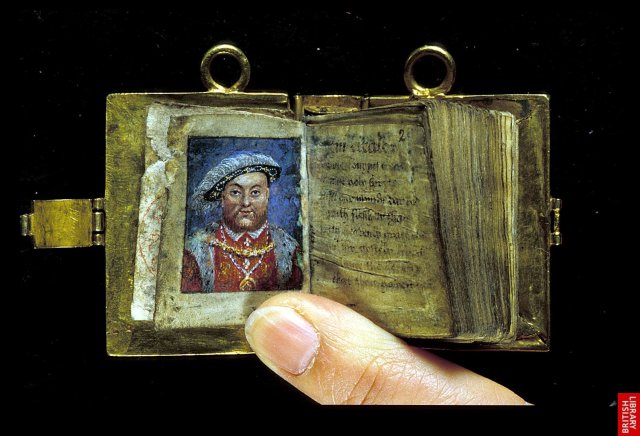By Jenny Weston
While most of the manuscripts produced in the Middle Ages are roughly the same size as today’s books, some volumes feature outrageous dimensions—either super-large or teeny tiny! Today’s blogpost is devoted to the ‘small-end’ of this spectrum, examining some of the world’s tiniest medieval manuscripts.
During the later Middle Ages, prayerbooks (and in particular ‘Books of Hours’) were often produced with smaller dimensions. These books were often favoured by women, who relied on their collection of prayers, psalms, and painted miniatures for their daily devotion. With smaller dimensions the book would have been lighter and easier to carry, which would have appealed to the devoted lady who wished to have the book on-hand throughout the day. (Such books could easily fit into one’s pocket or be attached to a girdle, see below.)
Here we can see a fourteenth-century example of a miniature prayerbook known as the Hours of Jeanne D’Evereux. Made in Paris by the artist Jean Pucille, this little book measures just 9.2 x 6.2 cm and could still easily fit into the palm of your hand.
The little book was originally produced under the patronage of King Charles IV as a gift to his third wife, Jeanne D’Evereux (1310-1371), who was only fifteen years old at the time of their marriage. It is a rather sweet idea to think that the book may have been designed with to fit the small hands of the young Queen.
It is likely that these tiny manuscripts also presented a tantalizing challenge to some ambitious scribes and artists, particularly those who wished to demonstrate their skill and precision on a tiny-scale. Despite the limited surface area, some books feature an impressive level of artistic detail, such as this fifteenth-century Book of Hours, which includes a number of illuminated portraits:

Miniature Book of Hours, Codex Manuscript 001054 © Rauner Special Collections Library (http://raunerlibrary.blogspot.nl/2013/05/a-beautiful-manuscript.html).
As noted above, the greatest advantage of a small book was its portability. By the thirteenth century, there was a growing interest in books that were easier to carry—friars and preachers, for example, often carried personal pocket-sized bibles with them as they wandered the streets (ready to teach and discuss the Word of God at any moment); students and scholars also benefited from these smaller, lighter books, as they were far easier to transport between the lecture-hall and home. Some of these books were attached to a piece of cloth, which could then be hung from a belt:
The tradition of ‘tiny-book-making’ has continued on since the Middle Ages, and it is still possible to find artisans making teeny-tiny volumes today.
On a final note, I could not resist adding this neat picture of an 18th-century leather bookcase from the Netherlands, designed to secretly house a collection of tiny books:





